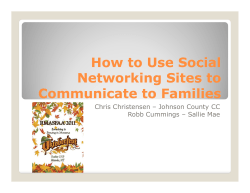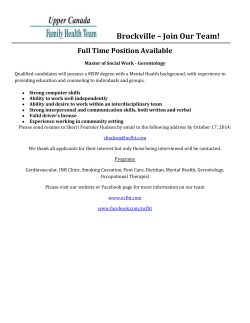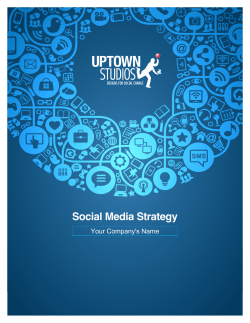
Ben Couste Gowri Ramachandran Josh Young Robert Idol
Ben Couste Gowri Ramachandran Josh Young Robert Idol Outline 1. Profiles 2. Reasons for use 3. Effects on business 4. Other consequences 5. Psychological effects • http://www.youtube.com/watch?v=I6IQ_FOCE6I • Gazillions of user accounts: Hotmail 370M, Facebook 600M, Twitter 200M • Flickr has 5 billion pictures, Facebok had 50+ billion (in July 2010) • Twitter users generate 65M tweets a day • Pushing the limits of scalability in computing, inventing new technologies on the way • Huge userbase • Devices! (hint: diversity) • Snowball effect (protests in the Middle-East and North Africa) • Aka Justin Bieber’s rise to World Domination™ • Certain sites have higher penetration rates in different countries • Russia still uses ICQ and VKontakte • MSN is preferred over AIM across the pond • Rampant piracy in Russia • No effort from the company to respond to takedown notices • China has its own giants, such as http://www.baidu.com/ • Profiles link users to other members o Extensive network results o Social networks important • Public display of connections o Explains reliability of identity • Social networking sites vs. dating sites o More serious deceptions easier on dating sites • Shopping cart of potential (soul|play) mates at your fingertips! • http://www.adopteunmec.com/ • Successful (corporate) model • All sorts of creative solutions Uses for Social Networking • Online interactions sometimes focus on meeting similar people Question Keep in touch with an old friend or someone I knew from high school. Check out a facebook profile of someone I met socially. Get information about people that live in my dorm, fraternity or sorority. Get information about people in my classes. Find out about a party or event at MSU. Have a face-to-face encounter with someone that I learned about through facebook. Find people to date. Find casual sex partners. Table : Mean responses to how likely respondents were to do the following. Higher scores equal more likely (Lampe et al., 2006) Social Networks as a Business • It’s all about advertising • Brand recognition Advergames • Monetization of information o The users are the product - they willingly provide information which can be used to target ads o Google Analytics o • Brands are eager to direct their customers to a social page than the traditional corporate site • Do you connect to brands through social media sites? • New ways for to reach consumers • Previously corporate web sites • Companies can create accounts on social media websites o Can create fan pages on Facebook or MySpace o Twitter allows companies to spread information to followers • Rewards for "like"ing a page • Taco bell • Smirnoff Vodka • UNC snoop dog • Food trucks • Let your customers do your marketing o Zynga (Farmville) o Minecraft o Will it blend? o OK GO • Social media networks allow companies to access younger markets and particular demographic groups. • Companies can reach consumers who uses mobile devices for product or company research. • Are corporate social media pages more or less personable than a standard website? o I choose to "like" something o "You have 5 friends who like this” Privacy Concerns • Burglary is increasingly plausible: http://www.cbsnews.com/video/watch/?id=6331815n&tag=relat ed;photovideo • Facebook is increasingly being used in divorce cases Personal information is available • Personal opinion groups impact relationships o • Defined as, “the use of information and communication technologies to support deliberate, repeated, and hostile behavior by an individual or group, that is intended to harm others.” • Most common among teenagers in middle/high school. • Extreme cases in recent memory have resulted in suicide. • http://www.youtube.com/watch?v=Br7nbQSIyhg Bullies might exhibit the following: • Pretend they are other people online to trick others • Spread lies and rumors about victims • Trick people into revealing personal information • Send or forward mean messages • 90% of teens are online. • Emergence of popular social networks have facilitated the growth of bullying • Strong links between bullying, depression and suicidal thoughts and attempts • Cyber bullying victims are nearly twice as likely to have attempted suicide as were nonvictims • Recent suicide at Rutgers University • New Jersey law that mandates antibullying training for teachers, administrators and school board members. • Some worry new laws are unconstitutional and limit free speech. • http://www.the33tv.com/n ews/kdaf-facebookwhitehousecyberbullyingstory,0,7265899.story • Parents? o Monitor internet usage • Schools? o Most Cyber Bullying takes place away from campus. administrators struggle with the limits of school authority in dealing with off-campus cyber bullying • Government? o Safe Schools Improvement Act proposed by Congress • What about bullying that results in suicide? Survey: 69 percent of adult respondents said harassing someone over the Internet should be a punishable crime o Phoebe Prince example o Questions? Questions 1. Facebook is commonly used as evidence in these legal cases. 2. Name any three of the notable social media types we have 3. 4. 5. 6. 7. 8. 9. mentioned. Which age group (young, middle-aged, old) is particularly targeted by companies who use social media sites? Is it easier to present false information on a networking site or a dating site? To which country does Vkonatke provide services? Are college users more or less likely to interact with users online whom they know offline? What are the most common reasons for college users to use Facebook? Are dating sites being replaced by social media sites? Who can help create a solution to cyberbullying? References Donath, J., & Boyd, D. (2004). Public displays of connection. BT Technology Journal, 22 (4), 71-82. How American companies use social media. (n.d.). Retrieved from http://thinkup.waldenu.edu/sales-and-marketing/marketing-and-publicrelations/item/12002-how-american-companies-use-social-media Krudy, E. (2010, March 19). New York food trucks turn to Twitter. Retrieved from http://www.reuters.com/article/2010/03/19/us-usa-twitter- idUSTRE62I4P220100319 Lampe, C., Ellison, N., & Steinfeld, C. (2006). A face(book) in the crowd: social searching vs. social browsing. Association for Computing Machinery, 167-170. Mohajer, S. (2009, May 15). Foodies flock to Twitter-savvy food trucks . Retrieved from http://www.msnbc.msn.com/id/30769388/ns/technology_and_sciencetech_and_gadgets/ Smalera, P. (2010, June 27). Are dating web sites past their prime?. Retrieved from http://www.washingtonpost.com/wpdyn/content/article/2010/06/26/AR2010062600189.html
© Copyright 2025





















